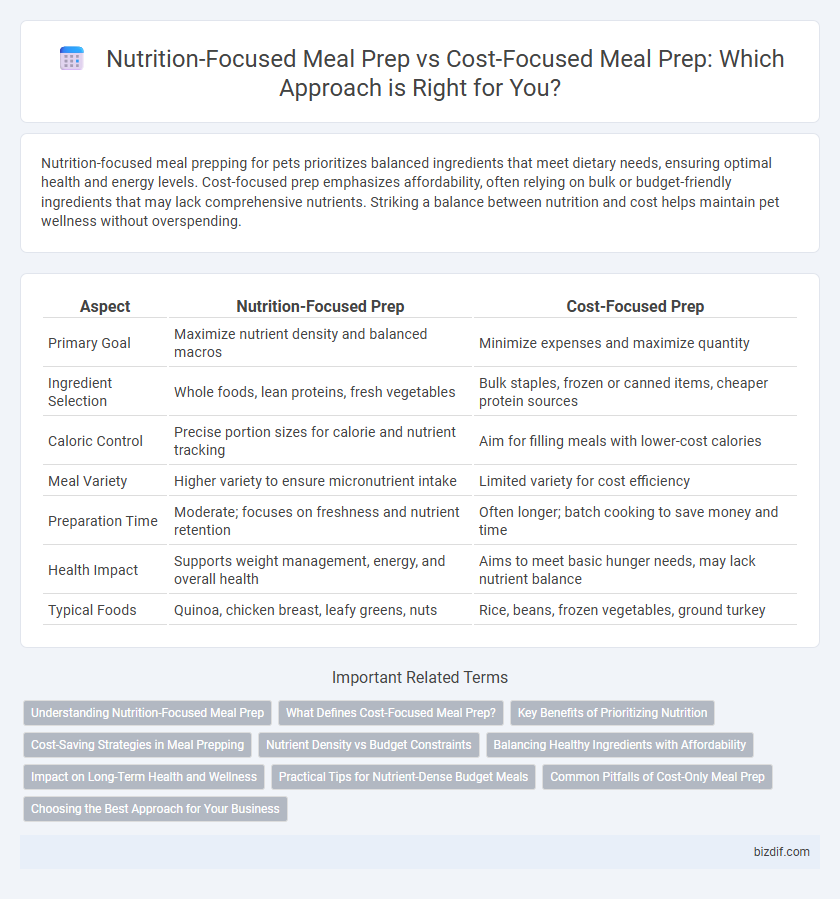Nutrition-focused meal prepping for pets prioritizes balanced ingredients that meet dietary needs, ensuring optimal health and energy levels. Cost-focused prep emphasizes affordability, often relying on bulk or budget-friendly ingredients that may lack comprehensive nutrients. Striking a balance between nutrition and cost helps maintain pet wellness without overspending.
Table of Comparison
| Aspect | Nutrition-Focused Prep | Cost-Focused Prep |
|---|---|---|
| Primary Goal | Maximize nutrient density and balanced macros | Minimize expenses and maximize quantity |
| Ingredient Selection | Whole foods, lean proteins, fresh vegetables | Bulk staples, frozen or canned items, cheaper protein sources |
| Caloric Control | Precise portion sizes for calorie and nutrient tracking | Aim for filling meals with lower-cost calories |
| Meal Variety | Higher variety to ensure micronutrient intake | Limited variety for cost efficiency |
| Preparation Time | Moderate; focuses on freshness and nutrient retention | Often longer; batch cooking to save money and time |
| Health Impact | Supports weight management, energy, and overall health | Aims to meet basic hunger needs, may lack nutrient balance |
| Typical Foods | Quinoa, chicken breast, leafy greens, nuts | Rice, beans, frozen vegetables, ground turkey |
Understanding Nutrition-Focused Meal Prep
Nutrition-focused meal prep emphasizes creating balanced meals rich in essential macronutrients like proteins, healthy fats, and complex carbohydrates to support overall health and energy levels. It involves careful selection of whole foods such as lean meats, vegetables, legumes, and whole grains to maximize nutrient density and promote optimal body function. This approach prioritizes meal variety and portion control to ensure adequate intake of vitamins, minerals, and antioxidants critical for long-term wellness.
What Defines Cost-Focused Meal Prep?
Cost-focused meal prep prioritizes affordability by selecting budget-friendly ingredients and utilizing bulk purchases to minimize overall expenses. It emphasizes maximizing calories per dollar, often incorporating staple items like rice, beans, and seasonal vegetables to stretch the food supply. The approach balances cost savings with basic nutritional needs but may sacrifice ingredient variety and nutrient density compared to nutrition-focused meal prepping.
Key Benefits of Prioritizing Nutrition
Prioritizing nutrition in meal prepping ensures balanced intake of essential vitamins, minerals, and macronutrients, supporting overall health and sustained energy levels. Nutrient-dense meals contribute to improved metabolism, enhanced immune function, and better weight management. Focusing on nutrition reduces the risk of chronic diseases while promoting long-term wellness more effectively than cost-focused meal prepping.
Cost-Saving Strategies in Meal Prepping
Cost-saving strategies in meal prepping emphasize bulk purchasing, seasonal produce, and versatile ingredients to minimize expenses while maximizing meal variety. Prioritizing nutrient-dense staples like beans, rice, and frozen vegetables reduces cost without sacrificing nutritional quality. Planning meals around sales, discounts, and store brands further enhances budget efficiency in nutrition-focused meal prep.
Nutrient Density vs Budget Constraints
Nutrition-focused meal prepping prioritizes nutrient-dense foods rich in vitamins, minerals, and antioxidants, enhancing overall health and energy levels. Cost-focused prepping emphasizes budget constraints by selecting affordable staples like grains, beans, and seasonal produce to stretch expenses without sacrificing basic nutrition. Balancing nutrient density with budget considerations ensures meals are both healthful and economically sustainable.
Balancing Healthy Ingredients with Affordability
Balancing healthy ingredients with affordability in meal prepping requires selecting nutrient-dense foods like lean proteins, whole grains, and fresh vegetables while considering budget-friendly options such as seasonal produce and bulk purchases. Incorporating versatile staples like beans, frozen vegetables, and canned fish can maximize nutrition without inflating costs. Strategic meal planning that emphasizes both nutritional value and economical choices supports long-term health and financial sustainability.
Impact on Long-Term Health and Wellness
Nutrition-focused meal prepping prioritizes balanced macronutrients and micronutrients, supporting sustained energy levels, immune function, and chronic disease prevention over time. Cost-focused prepping often emphasizes budget-friendly ingredients, which may compromise nutrient density and lead to nutrient deficiencies affecting long-term health. Optimal long-term wellness is achieved by integrating nutrient-rich foods within a cost-effective framework to maintain both health and affordability.
Practical Tips for Nutrient-Dense Budget Meals
Choose versatile, nutrient-dense ingredients like beans, lentils, and frozen vegetables to maximize both nutrition and cost-efficiency during meal prep. Prioritize whole grains and lean proteins in bulk purchases, then portion meals using airtight containers to reduce waste and maintain freshness. Incorporate seasonally available produce to enhance flavor and nutrient variety while keeping expenses low.
Common Pitfalls of Cost-Only Meal Prep
Cost-only meal prep often sacrifices nutritional balance, leading to meals high in processed ingredients and low in essential vitamins and minerals. This approach can cause energy dips and nutrient deficiencies, undermining long-term health goals. Ignoring variety and quality in favor of price typically results in repetitive, less satisfying meals that fail to support optimal wellness.
Choosing the Best Approach for Your Business
Nutrition-focused meal prepping emphasizes balanced macronutrients, fresh ingredients, and dietary customization, attracting health-conscious customers willing to invest in quality and wellness. Cost-focused meal prepping prioritizes affordability, bulk purchasing, and simplified recipes to maximize profit margins and appeal to budget-conscious consumers. Selecting the best approach for your business depends on your target market, supply chain capabilities, and long-term brand positioning in the competitive meal prep industry.
Nutrition-Focused Prep vs Cost-Focused Prep Infographic

 bizdif.com
bizdif.com